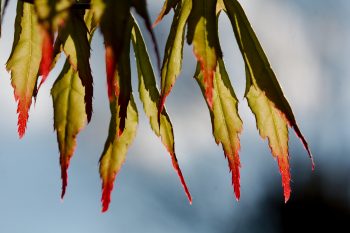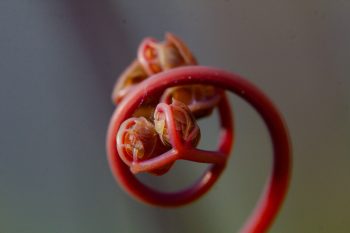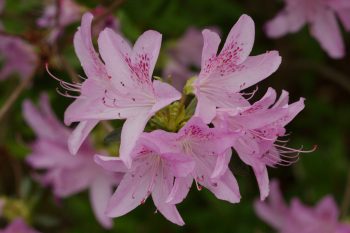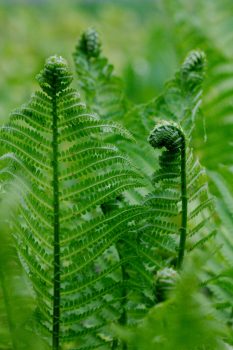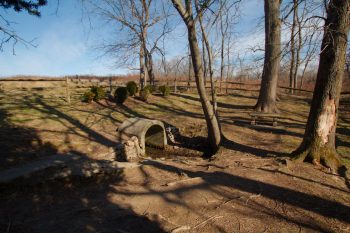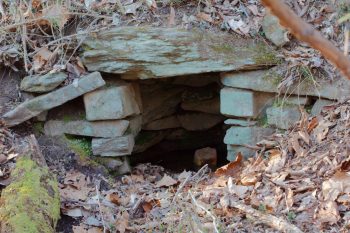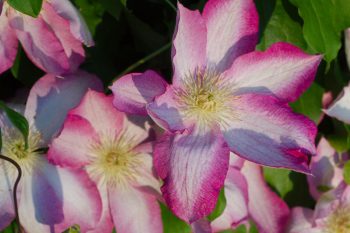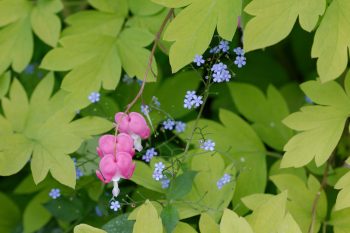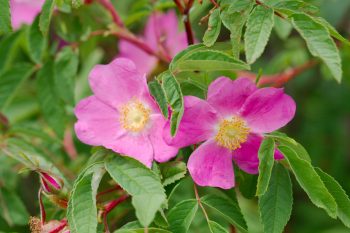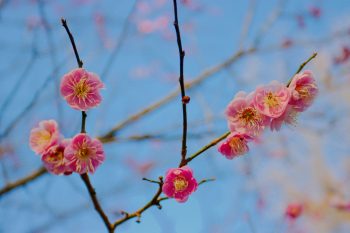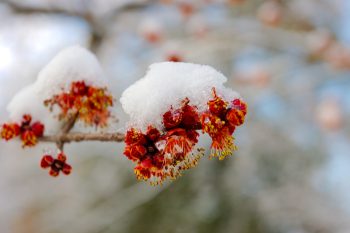I had a photo of dogwood leaves coming out of their buds recently (see Thursday, April 09, 2020) and they were pretty well liked on Instagram. That tree is a volunteer seedling that has been growing in a large bed in our back yard there there was once a large silver maple tree. That bed has been left pretty much to itself for quite a few years although we starting taking it back last summer and will do more this year. Along with the flowering dogwood (Cornus florida) there is a small maple seedling coming up. It’s close enough to the dogwood that we cannot really keep them both, but before I cut it out, I thought I’d post a photo of the new leaves coming out on it. It appears to have Japanese maple (Acer palmatum) in it’s makeup. But it’s going. Sorry.
Tagged With: Spring
Maple Leaves
Lily of the Valley (Convallaria majalis)
The lily of the valley (Convallaria majalis) is starting to bloom. We have it in a few places around the yard and these are at the front corner of our house where they get just a bit more sun than the other places so are a little ahead. It’s a lovely plant and has lovely, sweetly fragrant flowers but all parts of the plant are very poisonous so if that makes you nervous, you might want to avoid it. It contains cardiac glycosides, “a class of organic compounds that increase the output force of the heart and increase its rate of contractions.”
We dug some up in a yard that was being torn up when a road was being widened and it was growing through asphalt paving, so it’s pretty tenacious. We have it in a fairly large bed in the back yard but it is actually being forced outward by Vinca minor which I wouldn’t have thought possible.
Flowering Dogwood
I recently had a photo of dogwood leaves (see Thursday, April 09, 2020) which got some positive feedback. This is a flower on the same tree, a seedling that’s been growing on the edge of a flower bed in our back yard. I’m of two minds about this tree. On the one hand, any flowering tree has merit. On the other it’s not really where I’d want a flowering tree. There was a large silver maple (Acer saccharinum, not to be confused with Acer saccharum, the sugar maple) here but we had it cut down because it was large enough and leaning towards our house enough that we got very nervous every time there was a storm. We have a perennial bed where it once was, the this tree is right on the edge of that.
Maidenhair Fiddlehead
Our northern maidenhair fern (Adiantum pedatum) is coming up in the back garden. It’s really in much too sunny a spot and I think this year I really will split it and move at least some of it to a shadier, less dry spot. It does surprisingly well here, even so, only getting a bit burned late in the summer, especially in particularly dry years. It’s easily grown and one that should be in more gardens. I also think this is the year I’ll get a royal fern (Osmunda regalis), which has been on my wish list for a long while. Who knows, maybe I’ll even get around to making a water feature and bog garden.
Azaleas
Cathy and I took a break in the early afternoon and took a walk in the neighborhood. We got mail for someone else delivered to us (same house number, different street, happens fairly often) and we wanted to take it to the correct address. I carried my camera, as I usually do on walks, and took pictures of a few azaleas starting to bloom in the neighborhood. There are quite a lot around here, although most are just starting to come out. Soon the neighborhood will be full of color. Actually, it’s already full of color, but there will be more and different colors.
Frond of Ferns
I’ve used the joke before but it’s true, I’m fond of fern fronds. We have a few different ferns in the yard. There is the northern maidenhair fern (Adiantum pedatum, featured seven times so far, apparently), Japanese painted fern (Athyrium niponicum var. pictum), ostrich fern (Matteuccia struthiopteris), and sensitive fern (Onoclea sensibilis). This is, I believe, a Dryopteris species, but I need to do some work if I’m going to identify it for sure. The genus is generally known as the wood ferns but some species have particular names, like male fern (D. filix-mas, which is what I suspect this is) or buckler fern.
The other species this might be, and perhaps it’s more likely based on size, is the lady fern (Athyrium filix-femina). Both the male fern and lady fern are native and both are nice for a shady garden. I really should figure out which this is because every time I’m asked, I have to qualify my answer. A fern expert could probably look at my photo and tell me right off, but I need to look up the differences and look more carefully. If and when I do that, I’ll update this post.
Chives
The chives (Allium schoenoprasum) are blooming. These are one of the easiest herbs to grow and we have them both in containers on our back patio and in the ground in our herb garden. We have to keep the oregano from suffocating them, but they have managed to survive so far. They bloom this time every year and I like to pick some of the flowers to sprinkle onto food as a seasoning. They add a subtle oniony flavour without being overpowering. Of course, the tubular chive leaves can be used pretty much any time, but I think the flowers are special, because they add color as well as flavour.
Lily of the Valley (Convallaria majalis)
I know I’ve already had a picture this spring of the lily of the valley (Convallaria majalis) from our garden but it’s blooming so well and so long that I thought I’d share another. We’re also in a little lull where there isn’t a lot new coming out, although it’s still changing. So, here’s another view of the little white bells of the lily of the valley, this time from the back garden, near the fence (not that it makes much difference, of course). Soon the flowers will be gone and even the leaves will fade in the coming heat of summer. We are near the southern limit of where it grows well. If you grow it here, it needs some shade to protect it from the heat of the summer sun but further north it does well in full sun.
We also have a terrific crop of Canadian thistle (Cirsium arvense) coming up among it (and many other places, as well) and it really needs to be dealt with. That’s a really problematical weed, having “a deep and wide-spreading root system with a slender taproot and far-creeping lateral roots.” (Source: Fire Effects Information System, US Forest Service). That same document also says that “new plants can also form from root fragments as short as 0.2 inch (6 mm),” which helps explain why it’s so hard to get rid of.
Backlit Iris
Cathy and I went for a walk in the neighborhood this evening and came across this iris, back lit by the setting sun. It was more purple in real life but I think the photo is pretty nice, anyway. I have a thing for back lighting, particularly of growing things. I love the luminescent quality and amazing colors of leaves and flower petals lit by the sun. I also took photos of our hawthorn, which is in bloom, and the first rose to open on ‘Perle d’Or’ outside our front door. But there will be more chances to photograph those in the days ahead.
Sandy Spring
We went out for a walk this morning, going somewhere new, but it turned out that W.S.S.C. property requires a paid permit. The signage was very ambiguous, giving regulations for walking on the trails but then with big “No Trespassing” signs, but without an explanation of what constitutes trespassing. We decided to walk to Sandy Spring and enjoyed the walk very much. There is a champion white ash (Fraxinus americana) on the route, as well, which is a very handsome tree. There were other people out but no so many that it really affected our walk. The last time we came here we walked from Woodlawn Manor on the Underground Railroad Trail.
Meadowside Spring
Cathy and I went for a walk near Meadowside Nature Center this afternoon, heading upstream on North Branch Rock Creek. On the west side of the creek, back into the hillside a little, is this spring. I have no idea how long it’s been enclosed in stone but it has the look of something done quite a few years ago. For all we know, it predates the nature center and was built when there were homes or farms along the creek. There wasn’t a lot of water coming out but there was some, possibly enough for a small home if you work it right.
Chionodoxa forbesii
It’s been more than a couple years since I planted any new bulbs but of course, one of the beauties of bulbs is that they come up pretty reliably every year. Tulips aren’t that long lived, but daffodils and some of the smaller, more ephemeral blooms will likely be coming up long after I’m gone. This is one of my very favorite blooms, Chionodoxa forbesii, also known as glory of the snow. I like the fact that it blooms so early but I think my favorite thing about it is the amazing blue color. I really need to plant more of this.
Daffodils
Cathy, Dorothy, and I went up to Pennsylvania today to do a bit of work in the front yard. There is a small garden bed along the front of the cabin and it had become very overgrown. At the work day on March 13 we cut the small trees that were growing in it but today I dug up the roots of some of them. It was hard work and made a little harder because I wanted to avoid killing the peonies, irises, and lilies that were starting to come up among them. I didn’t take many pictures on this visit but I did take a few of the daffodils growing on the dam.
Erythronium americanum (Yellow Trout-Lily)
In our second attempt to reach Bluebell Island, we walked south on the Seneca Bluffs Trail from the parking area on Montevideo Road. Looking at the map, this comes close to the creek just below the island. We found, unfortunately, that when you get to that point, you’re on the top of the eponymous bluffs. We could have worked our way down to the creek but decided it wasn’t worth the effort. We could see that on the far bank of the creek the bluebells (Mertensia virginica) were blooming in great profusion. We saw other wildflowers and the hike was a success, in spite of the fact that we didn’t get to our planned destination. This yellow trout-lily (Erythronium americanum) is one of our prettiest spring flowers, photographed under some large Canadian hemlocks (Tsuga canadensis).
Clematis
We took a walk in the neighborhood this evening and I took this photo of a clematis growing on a mailbox a few blocks over. Whether you pronounce it KLE-ma-tas or kle-MA-tas, it’s a pretty thing. We have a few of them but none are doing exceptionally well. One doesn’t get enough sun (it was there when we bought the house and we talk about moving it but so far it hasn’t happened). Another was overshadowed by a rose bush. The rose is gone now but the clematis needs a bit more support than it has.
Bleeding Heart and Siberian Bugloss
After going to Fehr’s Nursery in Burtonsville, we stopped for lunch as a Cuban place on the way home. We could have picked a better day for it, as it was jammed for Mothers Day and it took us over an hour to get sandwiches. We’ll probably give them another try on a less busy day, but it was a bit off-putting. We drove to Woodlawn Manor and ate our sandwiches in the shade of one of their lovely trees. Then we walked around and I took a few photos, including a couple of the bleeding heart (Lamprocapnos spectabilis) and Siberian bugloss (Brunnera macrophylla, similar to forget-me-not) growing together under an America holly (Ilex opaca). Quite pretty, don’t you think?
Lily of the Valley (Convallaria majalis)
The lily of the valley (Convallaria majalis) is in full bloom right now. We have a large patch of it in the back yard and then smaller patches in a few other places. This is growing near the front corner of our house and it’s very happy. One thing about lily of the valley, at least for us, is that it seems to want to move. That is, the clump or colony spreads and the tail edge dies back, so the whole colony migrates over time. I’m not sure what, if anything, can be done about that.
Rosa davurica (Amur Rose)
Back in April of 2005 I planted 29 species roses in a bed I prepared on our property in Pennsylvania. Sadly, many of them did not survive, but there are a few that are still holding on and two that are actually thriving. This is one of those. It is, I think, Rosa davurica although the garden is in such bad shape, it’s not exactly clear where each rose should be. This rose has formed a small mound of plants about four feet tall and it is very happy. It’s absolutely covered with blooms and is quite lovely.
Early Cherry Blossoms, McCrillis Garden
We picked up Dorothy today and went to McCrillis Garden on Greentree Road this afternoon. It’s a wonderful little garden (five lots totaling about 4.8 acres) that’s especially lovely when the azaleas and rhododendrons are in bloom. But it’s worth a visit at other times of the year, as well, to see the sometimes less spectacular but still lovely plants. At the north end of the property there were a few cherry trees beginning to bloom. We also enjoyed seeing some of the ‘bones’ of the garden, including trees that have interesting shapes and structure even when they don’t have leaves. But seeing the blossoms was particularly nice.
Late Snow
March can be very spring like but can and usually does return to winter conditions again before it’s done. We’ve had some wonderful weather but then we just got a pretty decent snowfall and blustery conditions. Cathy and I went for a walk in the neighborhood and enjoyed the blowing snow and I took a few pictures, including this one of the snow on maple flowers around the corner from our house. It won’t do the tree any harm and it’s actually quite pretty. Within a few days the snow will very likely be gone and we’ll could be back into spring like temperatures.

